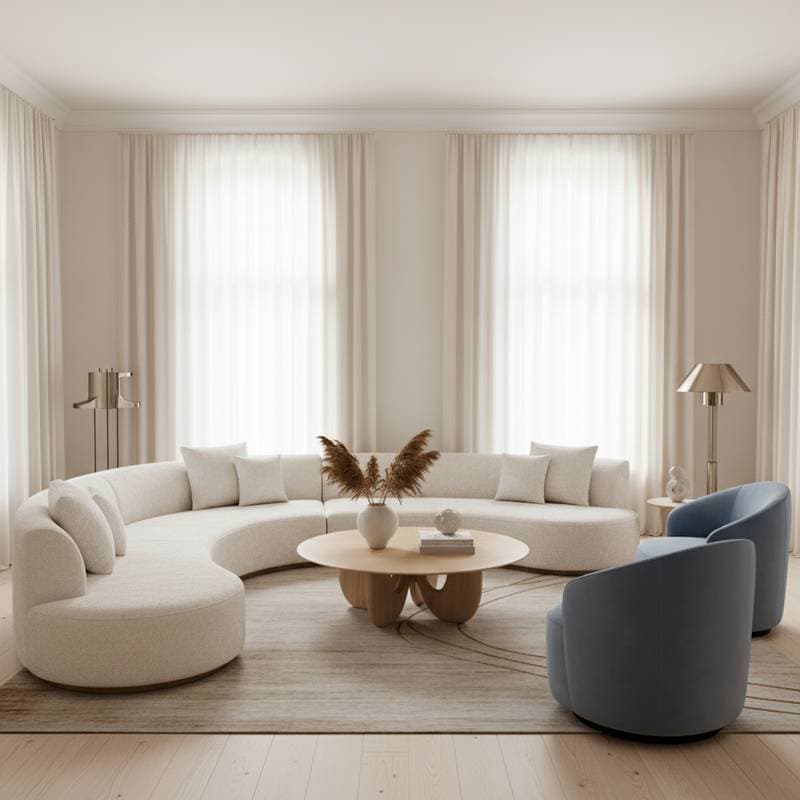Curved Furniture Needs Breathing Room to Work
Meta Description: Explore styling strategies for 2025's curved furniture trend to infuse warmth, fluidity, and equilibrium into interiors. Gain practical advice on integrating organic forms for a refreshed, harmonious living space.
Excerpt: Curved furniture defines 2025 interior design with its gentle contours that supplant stark minimalism. Crescent-shaped sofas and circular tables introduce serenity and movement to rooms. Discover techniques to harmonize curves with straight edges, select appropriate materials, and craft welcoming environments that blend modernity with intimacy.
Curved Furniture Emerges as a Dominant Force in 2025 Interiors
Curved furniture reclaims prominence in contemporary design, infusing spaces with warmth, ease, and a fluid cadence. Designers anticipate rounded profiles on sofas, tables, and decorative elements to lead discussions and exhibitions throughout the year.
Numerous residences retain the angular rigidity of prolonged minimalist phases. This article outlines methods to incorporate curved furniture and natural contours into existing layouts without undertaking comprehensive overhauls.
Curves flourish when granted ample surrounding space. Refrain from crowding compact areas or combining them with excessive vibrant motifs.
Essential Tools and Materials
To facilitate the integration of curved pieces, gather these items:
- Measuring tape for precise dimensions
- Painter's tape or string to map potential placements on the floor
- Furniture sliders or felt pads to maneuver items effortlessly
- Neutral fabrics and understated rugs to establish a foundational layer
- Form-emphasizing lights, such as compact table lamps
- Optional rounded-edge side tables or ottomans for supplementary accents
These tools enable experimentation without permanent commitments.
Recommended Practices and Pitfalls
Recommended Practices
- Integrate curves alongside straight lines to foster contrast and equilibrium.
- Simulate scale by marking outlines with tape prior to acquisition.
- Employ warm illumination to accentuate depth and subtle shadows.
- Select upholstery with robust foam interiors that maintain form over time.
- Maintain unobstructed pathways to sustain visual continuity.
Pitfalls to Avoid
- Position rounded sofas directly against walls, as this diminishes their sculptural effect.
- Cluster multiple large curves within confined areas.
- Rely on stark overhead lights that diminish surface texture.
- Overlook the underlying hue of floors or rugs, where bold designs may clash with furniture contours.
- Neglect ergonomic appeal; curves must encourage interaction beyond aesthetics.
Adhering to these guidelines ensures cohesive and functional arrangements.
Investment and Timeline Overview
Pricing for curved furniture varies considerably. Compact accent chairs or tables begin at accessible levels, whereas bespoke sofas or artistic installations command premium rates. Factors such as raw materials, artisanal techniques, and fabric selections determine the final cost.
The duration required hinges on procurement type. Off-the-shelf options typically arrive within weeks. Tailored creations may extend to months. Factor in additional delays for shipping, given the specialized handling curved forms demand.
The Contemporary Relevance of Curved Forms
Curved elements resonate with an escalating demand for domestic solace and connection. Individuals seek environments that evoke security and individuality following eras of austere visuals. Rounded profiles convey tenderness and accessibility, rendering spaces more inhabited and less institutional.
Furniture expert Mateo Cruz from the Design Institute of Living observes that curves mimic organic structures in the human form and natural world, thereby easing mental tension instinctively. This perspective underscores their versatility across aesthetics, from serene Scandinavian influences to resurgent mid-century motifs.
Selecting Appropriate Curved Elements
Consider these categories when building a collection:
- Sofa: Opt for a subtle crescent or arched profile that promotes dialogue in expansive living zones.
- Dining Table: Oval or circular designs enhance circulation in narrower settings and eliminate hazardous edges.
- Lighting: Arched or spherical pendants amplify the motif while conserving floor area.
- Rug: Irregular or rounded perimeters mirror the furniture's geometry.
- Accent Chair: Barrel or tub styles nestle into alcoves, providing bold yet contained sculptural interest.
Before finalizing choices, evaluate ceiling elevations and window alignments. Substantial curves require adequate vertical clearance to achieve proportional harmony.
Pitfalls in Curved Furniture Integration
- Excessive Uniformity: An abundance of matching arcs appears contrived. Blend subtle bends with pronounced sweeps for dynamism.
- Light Orientation Oversight: Strategic shadows enhance contours. Position sidelights to capture and amplify textures.
- Ceiling Neglect: A suspended orb above a curved sofa forms a cohesive orbital pattern.
- Incompatible Rugs: Angular mats interrupt momentum. Favor rounded or softly bordered alternatives.
- Proportional Disregard: Expansive curves demand generous rooms; diminutive ones adapt to tighter confines.
Addressing these issues prevents disjointed compositions.
Sustainability in Curved Design
Fabricating curves demands greater skill than linear constructions, yet advancements in wood curving and adaptable foam systems minimize material waste. Prioritize producers employing Forest Stewardship Council-certified timber or repurposed fabrics. Enduring organic silhouettes promote longevity, circumventing rapid obsolescence.
Designer Erin Cho of Studio Arc notes, “Curved furniture endures because it resonates on a human level. Connections form physically and sentimentally, encouraging prolonged retention.” This viewpoint illustrates how such designs advance both usability and ecological mindfulness.
Advanced Techniques for Refinement
- Incorporate mirrors to amplify a curved item's visual weight.
- Center illumination along the curve's axis to craft compelling shadow effects.
- Contrast textures, such as velvety fabrics against polished stone, to delineate outlines.
- Encircle pieces with vertical greenery or flowing curtains for contextual framing.
- Capture arrangements photographically from afar; lenses expose asymmetries overlooked in person.
These methods elevate basic setups to sophisticated levels.
Implementing Curved Enhancements
Embracing curved furniture requires no extensive remodeling. Initiate with modest introductions, validate positions through trials, and allow incremental additions to inform subsequent decisions. Curves respond positively to deliberate spacing and consideration.
This approach transforms interiors into sanctuaries where fluidity and subtlety foster enduring satisfaction.
